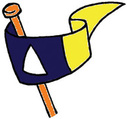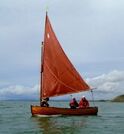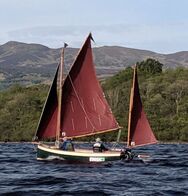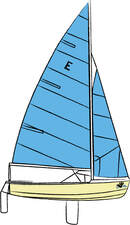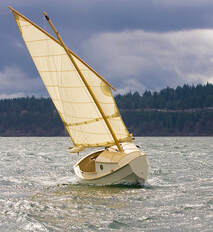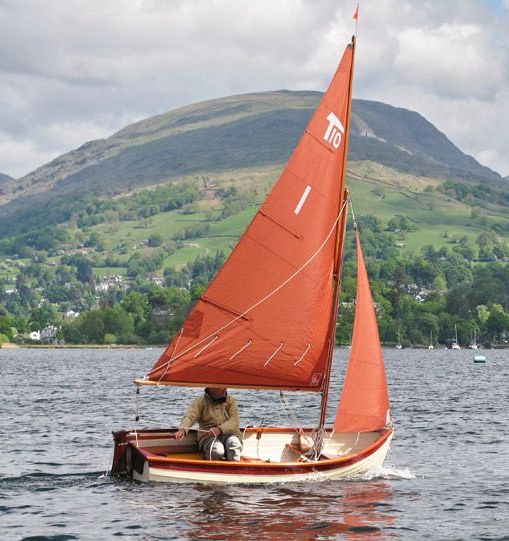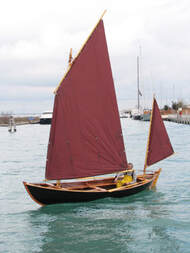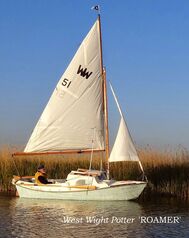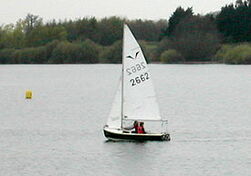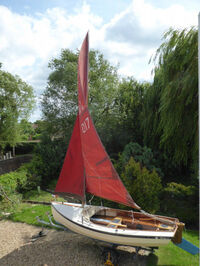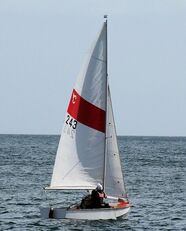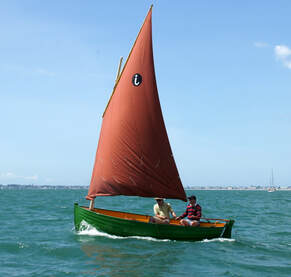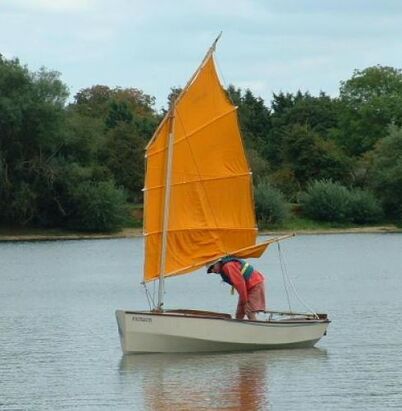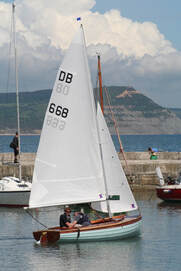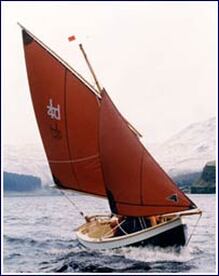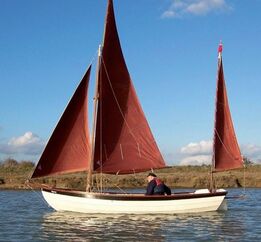DCA Members write about their boats
Here is a selection of articles taken from past editions of Dinghy Cruising in which DCA members talk about their boats, how they have adapted them and how they fare under different sailing conditions. These are the voices of experience and will help anyone considering whether to purchase a particular boat or not. Just click on the titles to open up the full article.
|
Puffin, a 13ft Cat Rigged Dinghy by Colin Bell DC 194 pp. 42-43
Having owned some twelve different sailing dinghies and cruisers over my lifetime and now having entered the seventies age group, I was looking for a stable, easy to rig, sail and launch sailing dinghy. She had to be big enough to sleep in and suitable for my grandchildren to learn to sail in, after they have read all the Arthur Ransome books. |
|
A Suffolk Beach Punt by Paul Harrison
DC 193 pp. 52-54 It’s ten years since Ian Page and myself bought our Suffolk Beach Punt Peregrine. It’s seen us safely through many trips from the West Coast of Scotland, to the Outer Hebrides, The Lakes, The Farne Islands, Anglesey, The Humber, The Norfolk Broads, Falmouth, The Solent and even our local sailing pond Pugneys in Wakefield. |
|
|
Paradox by Duncan Gilchrist DC193 pp. 45-47 and
Sailing the Paradox by Alastair Law DC193 pp. 48-49 Man has long admired a nicely-rounded bottom. Since he first sat astride a log and tried to stay on top of it to the other side of the river, rounded bottoms have offered excitement and sometimes even satisfaction. So, one has to be brave to ignore this long-held love of curves and to present to the world a boat that is square. Worse than that, the designer added protuberances to the outsides of the already sharp chine. He then had the audacity to claim that this box would sail well to windward without the aid of a keel, centreboard or leeboard, on its bare flat bottom! |
|
Nineteen years with an Enterprise by Steve Bradwell DC 211 pp. 43-45
Designed by Jack Holt and first launched in 1956 the Enterprise is a popular club racer, which excels in light wind tactical lake sailing. It is one of the most numerous classes in the UK and around the world. Club racing is what most do but it was also intended as a family cruising and a ‘general purpose’ boat. For this use cruising sails were designed. These have a total sail area of 7.43 sq m / 80 sq ft. Racing sails are 10.5 sq m / 113 sq ft. New Member’s Boat by Simon Rippon DC 233 p. 60 Simon writes about his Enterprise Kindly Light. |
|
The Evolution of Scamp by John Welsford DC 210 pp.56-57
Magazine co-editor Josh Colvin and I have corresponded for a long time, and it was both a pleasant surprise and a compliment to me when he asked me to design the smallest practical cruiser which would become the ‘Small Craft Advisor Magazine Project’. Otherwise known as SCAMP. The brief was for a boat as close to 3.048m (10 ft) long as possible, to sleep one on board, to sail two or three for a few hours, to carry a weekend’s stores and equipment, and to be within the capabilities of a first-time boat-builder with only basic tool skills. Scamp Evaluation by Howard Rice DC 211 pp. 55-60 |
|
The Tideway by Richard Crockatt DC182 pp.34-36
First impressions count for a lot. I vividly remember my first sail in a Tideway on a wet and blustery day in Blakeney Harbour on the North Norfolk coast. I felt a mixture of admiration for the boat’s qualities in testing conditions and relief that at last I’d found a boat I could manage single-handed with some ease on and off the water. I’d had a GP14 before, which is a fine boat, but in force 4 and above is a lot to handle on your own. In my search for the ideal boat I had sailed all manner of other dinghies and found them too big or too small or too light or too heavy etc etc. The Tideway seemed spot on. No doubt it’s partly a question of temperament. Boats fit like clothes, and choice of clothes is a highly subjective matter. |
|
The Ness Yawl by Alan Glanville DC 184 pp.61 and 63
The Ness Yawl is long, slim and light, enabling her to slip through the water easily. Designed by Iain Oughtred and based upon the traditional Ness Yoles of the Shetland Islands, she is a direct descendant of the double-ended, open-hulled Viking boats of Scandinavia. Her most outstanding feature in my eyes is beauty; aesthetically the boat is a delight. This is in no small measure due to her suitability as a sailing and rowing boat: she is fun to sail and easy to row. My own Ness Yawl, Lowly Worm III, is rigged with a standing lug mainsail and a Bermudan mizzen. Other sail configurations are possible. The masts are unstayed which makes launching and recovery easy and low bridges negotiable without difficulty. |
|
The West Wight Potter by Bruce Longstaff and Bob Lomas DC 208 pp. 59-61
The ‘West Wight Potter’ originated in a western corner of the Isle of Wight. It was designed and originally built by third generation boat-builder and designer, Stanley Smith and was intended to be a boat in which one could ‘potter’. Stanley Smith’s criteria for the Potter was a boat that could be easily towed by a Morris Minor, could be stored in the garage, and would be seaworthy enough to take any seas the Solent had to offer. In his design the latter was more than adequately catered for, as proved when he sailed one of his early Potters from the Isle of Wight to its new owner in the north of Sweden, crossing the North Sea in gale force winds one cold October. |
|
The Gull – The Perfect Boat for Me by Chris Abela DC 215 pp. 41-43 Just the other day I was working on the 12th story of a tower block that directly overlooked the reservoir where I first launched my Gull dinghy Aurora nearly 9 years ago. This prompted me to write a few words about this excellent little boat and what I have learnt about her since. |
|
The Westray 16 Cruising Dinghy by Tim Davis DC 233 p. 57 It was purely by chance we stopped off at Peter Clark’s boatyard at West Mersea, while on our way home, to look at a Westray 16 I had previously seen for sale and had thought might be worth a look. How fortuitous this was, as immediately I realised that all my ideas of what I thought I wanted in a cruising dinghy were sitting here in front of me: deep cockpit (for a dinghy at least), raised foredeck with enough room to sleep under and turn over, three quarter-decked with comfortable sitting, in or out, and all within a feasible weight balance for day sailing. |
|
The Seafly: A Potential Cruising Dinghy? By Peter Taylor DC 214 pp.38-40 In the last issue of Dinghy Cruising there were photographs of Gavin Millar and myself enjoying the autumn winds on the River Itchen. I was out sailing my SEAFLY dinghy single-handed in the stiff breeze. Later, back on land, Idiscussed with Gavin just how suitable the SEAFLY might be for dinghy cruising. The one major factor which makes it worth considering the boat for cruising is that, despite its being a reasonably fast 'racing dinghy', it is remarkably stable and well-behaved. |
|
My Seagoing Dinghy by Roger Barnes DC202 pp. 34 and 39-42
Initially I had decided to buy an Iain Oughtred designed Ness Yawl, like Alan Glanville’s, but while I was in France I became reacquainted with the small boat designs of François Vivier, ubiquitous in Brittany, and in particular with his ‘Ilur’ design: a beamy and capacious fifteen-footer, with an unstayed mast stepped right in the bows, leaving lots of unencumbered space for dinghy cruising. The Ilur had the air of an admirably practical and seaworthy design and, most importantly, had a nice wide flat floor for sleeping on. I was rather worried about the rig – a single lugsail with very traditional gear – and wondered how practical it would be for serious cruising, compared to the much more conventional gunter rig of the Tideway. But surely generations of Breton fishermen could not be wrong? |
|
Building and Using the Selway Fisher 12’ Highlander
by Antony Sluce DC 185 pp.68-72 Fraoch was the fourth boat I had built. The first was a flat-bottomed 11' dinghy to my own design using the stitch-and-glue technique made popular by the Mirror, then I bought a fibreglass 16' Shetland Skiff hull and fitted it out as a gunter-rigged sloop. When the family became too big for this I bought an 18' Express Pirate kit which we completed one summer holiday on the front drive. These boats were all used extensively for family cruising in the West Country, the Lakes and the west coast of Scotland. Later, after a few heart attacks and having handed the farm over to my cousin, I decided to convert Fraoch to a sailing dinghy. Also I had lost my crew as my children got married and I needed a smaller boat that I could handle ashore by myself. So reluctantly I sold the Pirate and started work on Fraoch. I was a little concerned about my ability to sail a dinghy again as I had been in keel boats for so long. If you read on you will see it was a quite unnecessary worry and the Highlander has proved an ideal boat for my type of sailing. |
Boats at Beale: Alan Moulton describes the 14ft Yachting World Dayboat and Keith Muscott describes the 12ft Farthing From Willow Bay Boats DC 232 pp. 71-73
|
In 1949, the same year that Jack Holt designed the GP14, Yachting World magazine published details of a 14ft dinghy that George Kennedy O’Brian had been commissioned to design. This was a round bilged general purpose boat, intended to be easily built by an amateur using several possible methods including clinker, carvel and double diagonal construction. It was to be called the Yachting World Dayboat and was aimed at family knockabout sailing in open waters, rivers and estuaries.
|
|
Selway Fisher's Petite Brise 16 by Maurice Burgess DC219 p. 35 A quick snapshot of a handsome cruising yawl design, which Maurice built and named Osprey. The PB16 version grew from the original Selway Fisher 12ft 4ins PETITE BRISE and both boats are developments from the classic Swampscott Dory, but with increased beam, stability and aft buoyancy. |
The friendly club with a sense of adventure. For all sailors who use boats for more than just racing.
|
© 2010-2024 DCA. All Rights Reserved. |
|
